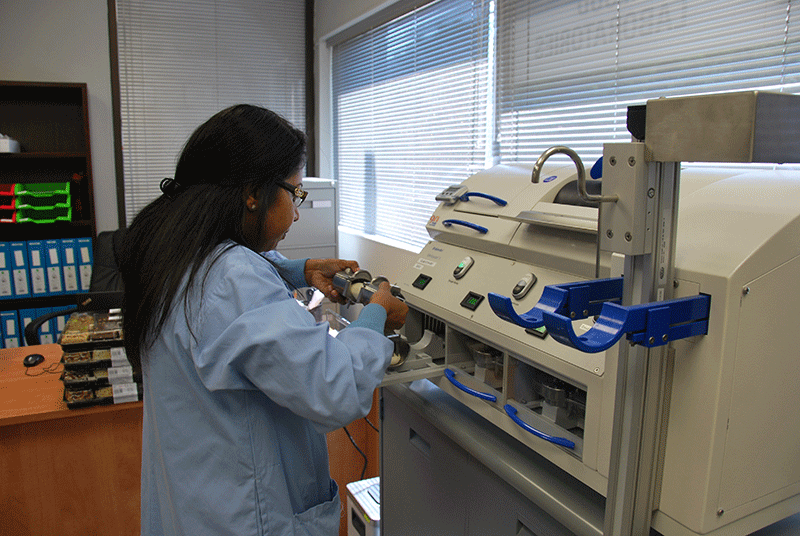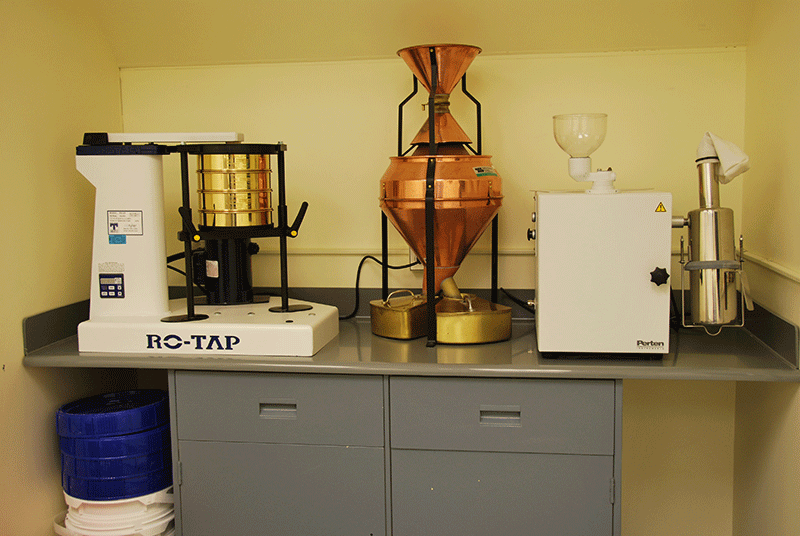Quality assurance
GRAINS ANALYTICAL TESTING LABORATORY OPENS
CONSUMERS WANT MORE information about their food, not less. Food processors want to know the ingredients they are buying will meet consistency standards. And exporters want to sell a quality product that will maintain Ontario’s status as a reliable source for commodities.

The new Grains Analytical Testing Laboratory will meet all of these needs within the cereal grains value chain.
“What customers are looking for is a greater level of transparency of the food chain,” says Don Slobodzian, vice president of agriculture and food, SGS Canada. “We all know that wheat has many handoffs in the value chain and it transforms in the value chain. Every time it has a hand off, those customers are looking for science and a depth of knowledge in the quality attributes of the ingredients they are buying.”
The Guelph, Ontario based Grains Analytical Testing Laboratory is a joint venture between Grain Farmers of Ontario and SGS Canada. SGS is the world’s leading inspection, verification, testing, and certification company which operates a network of over 1,800 offices and laboratories around the world. This is the first time a producer organization and a private company have joined to open a lab of this nature in Canada.
“Market development is one of the key pillars of Grain Farmers of Ontario. The lab will help us gain a better understanding of the quality of our wheat which will help us target specific markets for it,” says Barry Senft, CEO of Grain Farmers of Ontario. “Our partnership with SGS gives us the unique opportunity to capitalize on their experience and reputation. Their technical expertise and interpretation of analytical data will help us better position Ontario cereal commodities within both domestic and international markets.”
EXPERT ANALYSIS
The lab has full commercial capabilities for Ontario, Canadian, and North American millers and processors. It is equipped to conduct rheological testing, physical dough and bake testing, and protein level testing.
Paolo Santangelo has been hired as the commercial manager of the Grains Analytical Testing Laboratory. He brings more than 12 years of experience in the manufacturing of food ingredients, including most recently with Rogers Foods Ltd. serving as director of quality and technical sales. He holds a BSc. in biological sciences from the University of Lethbridge; a diploma in pure and applied science from John Abbott College; a diploma of practical milling from the Association of Operative Millers; and is a certified baker through the American Institute of Baking.
“There is no one test that is more relevant than another. It is a package of information that needs to be considered and how it relates to the end use,” notes Santangelo. “For example, farmers tend to believe that high protein is what is wanted, but that isn’t necessarily the case depending on what the wheat is being used for. Every process needs different parameters, values that we will obtain from these tests.”
Knowing which cereal varieties are meeting the needs of industry will help farmers plan their crop rotations and help with their ability to market their grains.
“Ontario has the ability to become a global leader in the grain industry,” says Senft. “We don’t produce the large volume of wheat that other regions do — but we can differentiate ourselves by providing the consistency and quality that processors are looking for.”
“You need to continue to improve and innovate, and you need to continue to ensure that you have great relationships with customers,” says Slobodzian. “One of the fundamentals in a good relationship is trust and transparency in the pipeline and so this is an opportunity for producers in Ontario to know that they are going to have the confidence of global importers and food ingredient processors and a strong market for their product.”
BROADER IMPACT
In the future, the lab will also offer quality tests for corn and soybeans to provide value to all of our farmer-members and ensure we are maximizing the potential of these commodities in domestic and international markets.
In addition to analyzing samples for millers and processors, staff at the Grains Analytical Testing Laboratory will be conducting the tests for the annual Ontario Wheat Quality Scoop coordinated by Grain Farmers of Ontario. The harvest survey results will be published online under the Production section at www.gfo.ca.
Santangelo will also evaluate the current quality of Ontario wheat against that of what millers and end users are looking for to identify where any gaps may exist.
Farmer-members who are interested in learning about the quality of their own crop can submit samples to the lab. Pricing for this service has not been set, but more information is available by contacting the Grains Analytical Testing Laboratory directly.
WHAT’S IN THE LAB?

MILLING ROOM
A lab mill mimics what a larger scale mill can do. Six streams of flour are created and collected separately. The endosperm is separated from the bran and further processed into flour.
The Ro Tap machine is a series of screens that the product passes through to determine what the particle size differentiation is within the sample.
The grain divider is used to mix and then divide the grain that is received for testing into a smaller sample size.
BAKING ROOM
The fermentation cabinet is a place to rest and proof the dough in a timed, temperature, and humidity controlled environment to ensure consistent baking results.
MAIN LAB
The Glutomatic separates the gluten from the starch material which allows technicians to measure what the weight and percentage of gluten is in a sample of wheat or flour.
The Shakematic shakes a test tube with flour and water before it gets put into the falling number machine (a hot water bath) for the amount of alpha amylase activity to be measured.
The amylograph measures alpha amylase activity within the sample and how the starch behaves as the temperature increases.
A kernel counter is used to obtain 1,000 kernels for a weight test. The heavier it is, the more endosperm there likely is, which could mean more flour is extractable from that sample.
The farinograph, used to mix flour and water into a dough, measures the level of resistance that is present after the water is added. Peak resistance is measured (an indication of dough strength) as well as the drop in the curve as the dough degrades with continuous mixing.
Discs of dough are rested in the Alveograph chamber and then air is injected to create a bubble. The resistance to expansion by the dough is used as a measure of extensibility. The doughs extensibility is determined by how big the bubble gets before it pops.
The NIR machine measures the amount of moisture in the grain which helps to determine the amount of water that needs to be added to the cleaned grain for tempering prior to the milling process.
The SDmatic measures starch damage. Starch damage is expected when you mill, some damage is good for baking, but not too much, which is why bakers like to know this number.
An extensograph stretches a sample of dough until the point of snapping. The amount of resistance is measured along with the length of the dough. This test is performed at three intervals of rest (45 minutes apart) to assess how the flour changes properties over time. •






















